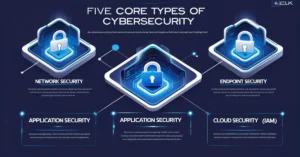With all of our hyper connection, areas of cyber security have become more critical than ever before. Because hackers are becoming sneakier, every business and individual is targeted daily by cyber attacks, so it is imperative to know the most important methods that can keep us safe. Just imagine what it would be like to wake up and find out your bank account was emptied or your company was hacked by the use of ransomware, the latter more relevant today than ever.
The present article takes a plunge into the top 7 critical areas of cyber security in 2025, simplified in terms used to understand all people. We will present real-life examples, present practical tutorials, give tips to make you a better person, and we will show you how. And in targeting these areas of cyber security, you shall be prepared to face the challenge of cyber threats with much confidence.
Related to technologies such as artificial intelligence (AI) and the Internet of Things (IoT), the cases of cyber attacks have increased by more than 40 percent within the last year alone.
On top of that, we will demonstrate that AI will enable you to keep yourself safe with ease. To start with, let us look at the key areas of cyber security that you should be well-versed in!
5 Types of Cyber Security: Building a Strong Foundation
The 5 types of cyber security topics that we are discussing here are at the foundations of safeguarding our online lives. These are network security, endpoint security, application security, cloud security and identity and access management (IAM). Both of them attack particular vulnerabilities and provide complete defense.
As an illustration, imagine a small retailer that did not care about endpoint security. A hacker infected the tablet of a cashier with malware to steal the credit card data of customers. With adequate defenses, this could have been avoided. To begin with, the following is a step-by-step plan to eliminate these 5 types of cyber security:
- Secure Networks: Secure networks are the networks that use Next-Generation Firewalls (NGFW).
- Protect Endpoints: Use Endpoint Detection and Response (EDR) in assets like laptops.
- Hardened Applications: Make use of safe coding practices in building apps.
- Safeguard Cloud Data: Use Cloud Access Security Broker (CASB).
- Use IAM and the multi-factor authentication (MFA) to control access.
By covering these 5 types of cybersecurity, you create a solid defense. Learn more at the SANS Institute.
Cyber Security Examples: Real-World Protection in Action
To understand the areas of cyber security, let’s look at cyber security examples that show their impact. Take the 2017 WannaCry ransomware attack, which locked hospital systems worldwide due to weak network security. Render type a tech firm used zero trust security to stop a hacker who tried to sneak in via a compromised vendor account. These cases highlight how different areas of cyber security save the day.
These are the ways that you can use to apply cyber security examples:
- Use Firewalls: Hack Firewalls against unauthorized access, such as in the case of WannaCry.
- Train Employees: Teach the employees to recognize phishing emails.
- Encrypt Data: Secure confidential data by data encryption.
The examples of cyber security in the real world show that active measures succeed. Check NIST’s Cybersecurity Framework for practical tips.
Types of Cyber Security Jobs and Salary: A Growing Field
The areas of cyber security offer exciting career paths. Types of cyber security jobs and salaries vary, but demand is soaring. Roles like security analysts ($80,000–$120,000 annually), penetration testers ($90,000–$150,000), and CISO ($150,000–$300,000) are hot in 2025. A recent grad landed a security analyst role after a boot camp, doubling her income in a year.
To break into these types of cyber security jobs:
- Learn Basics: Take courses from Cybrary.
- Get Certified: CompTIA Security+ or CISSP.
- Gain Experience: Internships or entry-level opportunities.
- Specialized: Conducted a choice between AI security and cloud security.
Explore salaries at Glassdoor.
What are the 3 Biggest Types of Cyber Security?
When asked, what are the 3 Biggest Types of Cyber Security? I think network security, endpoint security, and application security. These form the backbone of most defenses. For instance, the Equifax breach exposed millions due to weak application security. To implement these 3 major types of cyber security:
- Network Security: Use Intrusion Prevention Systems (IPS).
- Endpoint Security: Deploy EDR tools.
- Application Security: Conduct vulnerability scans.
These major areas of cyber security are critical. Learn more at OWASP.
Which Field of Cyber Security Is Best?
Wondering which field of cyber security is best? It’s up to you what u wanna do. AI security is booming due to Generative AI risks, while cloud security is key for businesses moving online. Penetration testing is great for hands-on techies. Anecdote: Mike, a cloud security expert, helped a startup avoid a breach, earning a big promotion.
To choose:
- Assess Interests: Love coding? Try application security. Analytical? Go for AI security.
- Research Demand: Check Cybersecurity Ventures for trends.
- Upskill: Use platforms like Pluralsight.
No single field is “best,” but AI security is trending in 2025.
Importance of Cyber Security: Why It Matters
Cyber security is immensely important. Cyber attacks such as ransomware and phishing have the potential to destroy companies and cost billions every year. Cyber security ensures:
- Data Protection: It safeguards secret information.
- Business Continuity: Eliminates failure.
- Reputation: Earns customers’ trust.
To prioritize the importance of cyber security:
- Conduct Risk Assessments: Use NIST tools.
- Train Staff: Focus on phishing awareness.
- Invest in Tools: Like Grok for real-time insights.
Stats can be found over at IBM Cost of a Data Breach.
How Many Types of Cyber Security Are There?
How many types of cyber security are there? Although different checklists exist, professionals commonly identify 7-10 major areas of cyber security, such as network, cloud, endpoint, IoT, application, zero trust, and supply chain security. Each tackles unique cyber threats.
To cover all areas of cyber security:
- Audit Systems: Find your technology stack.
- Prioritize Risks: Pay attention to weak areas of cyber security.
- Integrate Solutions: Use a hybrid mesh architecture.
View Check Point’s Report for more.
Cyber Security Threats: Know Your Enemy
The nature of the cyber security threat is changing and is now phishing and Gen V attacks. The SolarWinds hack demonstrated the use of supply chains to exploit trust in this context. Anecdotally: A ransomware attack hit an unpatched system at one hospital, causing surgery delays.
To combat cyber security threats:
- Monitor Activity: Use SIEM tools.
- Patch Systems: Update software regularly.
- Backup Data: Ensure data recovery plans.
Please refer to CISA’s Alerts for Updates.
Areas of Cybersecurity Focus: The Top 7 in Depth
Now, let’s dive into the areas of cybersecurity focus for 2025, which align with our key areas of cyber security:
- AI and GenAI Security: Protects against AI-driven phishing and deepfakes. Use OWASP guidelines.
- Zero Trust Security: Verifies all access with IAM and micro-segmentation.
- Cloud Security: Secures data with CASBs and data encryption.
- Network Security: Uses NGFW and IPS.
- Endpoint Security: Protects devices with EDR.
- IoT Security: Secures smart devices with network segmentation.
- Supply Chain Security: Vet vendors to prevent attacks like Kaseya.
These specific areas of cybersecurity are your shield. Visit Cloud Security Alliance for resources.
Conclusion:
We’ve explored the areas of cyber security critical for 2025, from AI security to supply chain security. With stories, guides, and tips, you’re ready to face cyber threats. But you need the right tools to stay ahead.
That’s where xAI comes in. This AI-powered assistant analyzes cyber security threats, offers tailored solutions, and answers queries instantly.




